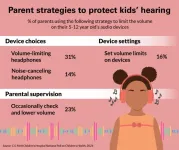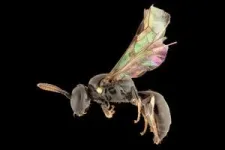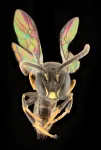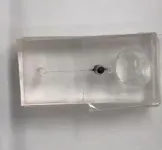(Press-News.org) ANN ARBOR, Mich. – While it’s not surprising to spot teens wearing headphones and earbuds, it’s also becoming a widespread trend among younger children, a national poll suggests.
Two in three parents say their child ages 5-12 uses personal audio devices, with half of parents of children ages 5-8 reporting elementary-aged kids use a device.
Among parents whose children use headphones and earbuds, half say kids spend at least an hour a day using them while one in six say a typical day for their child includes at least two hours of use, according to the University of Michigan Health C.S. Mott Children’s Hospital National Poll on Children’s Health.
“Over recent years we’ve mostly been concerned about teens overusing audio devices. But earbuds have become increasingly popular and prevalent among younger kids, exposing them to more intense noise on a regular basis,” said Susan Woolford, M.D., M.P.H., Mott pediatrician and co-director of the Mott poll.
“Noise exposure risks to young children have historically involved loud singular events like concerts or fireworks, but parents may underestimate the potential harm from excessive use of listening devices. It may be difficult to know whether their child’s exposure to noise is healthy.”
Children are most likely to use these devices at home, school and in the car, report findings show. About a fourth of parents also say children occasionally use audio devices on airplanes while less than 10% say kids use them on the bus, outside or in bed.
Half of parents agree that headphones or earbuds help keep their child entertained.
The American Academy of Pediatrics released a statement in 2023 on the need to reduce noise risks to children, with increasing evidence that children and teens may be more exposed through personal listening devices.
Prolonged or extreme exposure to high volumes of noise can result in long term health issues, including hearing loss or tinnitus, Woolford says.
“Young children are more vulnerable to potential harm from noise exposure because their auditory systems are still developing. Their ear canals are also smaller than adults, intensifying perceived sound levels,” Woolford said.
“Tiny hair cells inside the inner ear pick up sound waves to help you hear. When these get damaged or die, hearing loss is irreversible.”
Noise exposure among children can also affect their sleep, academic learning, language, stress levels and even blood pressure, she adds.
More parents of children aged 9-12 years than 5-8 years report their child uses headphones or earbuds and daily use was also more likely to be higher among the older age group, the poll suggests.
But only half of parents share they’ve tried to limit their child’s audio device usage, citing strategies such as asking the child to take a break, having set hours for use and using a timer.
Parents whose child uses headphones for more than two hours a day are also less likely to set time or volume limits, compared to parents who report less headphone use for their child.
Woolford offers four tips to reduce risks of noise exposure to children through headphones and earbuds:
Monitor volume levels
Parents can minimize the negative impact of audio device usage by monitoring and adjusting the child’s volume and time on devices, Woolford says.
She recommends parents follow the 60/60 rule – children should be limited to no more than 60 minutes of audio devices a day at no more than 60% of the maximum volume.
The sound level on listening devices that are less than 70 dBA (relative loudness of decibels heard) are very unlikely to cause noise-related damage.
“A good way to tell if an audio device is too loud is if a child wearing headphones can’t hear you when you’re an arm’s length away,” she said.
Parents can also limit their child’s risk by setting specific hours for audio device use or using a timer to keep track.
Use noise cancelling or volume limiting headphones
Parents should consider the risk of noise exposure when purchasing audio devices for their child by checking the information on device packages to identify products that limit the volume.
But some products marketed as “kid safe,” Woolford warns, do not limit the volume to 70 decibels.
However, children should avoid using noise-cancelling listening devices in situations when perception of sounds is crucial for safety.
“Noise-cancelling devices may help prevent children from increasing the volume to levels that are too high,” Woolford said. “But these devices shouldn’t be used when a child is engaged in activities where it’s important to hear their surroundings for their safety, such as walking or bike riding.”
Ensure kids take breaks from personal listening devices
Parents should help children intentionally have daily “device-free” time, Woolford says. This may involve putting away or locking the child’s audio devices when time limits are up.
They may also encourage kids to enjoy things like music on a low volume in their rooms instead of using earbuds to reduce noise intensity.
Personal audio devices should also be avoided when children are sleeping or at bedtime, Woolford says.
Be mindful of early signs of hearing loss
If parents feel their child may be at risk of hearing loss due to using audio devices, Woolford recommends checking with a pediatrician, an audiologist, or an ENT (ear, nose and throat) specialist.
“Early signs of hearing loss may include asking for repetition, hearing ringing noises often, speaking loudly to people nearby, delayed speech, or lack of reaction to loud noises,” Woolford said.
“Healthcare providers may be of assistance to parents by offering a simple explanation about hearing loss to help the child understand the reasons for limiting their use of audio devices.”
END
Can they hear you now? Kids increasingly exposed to noise health risks via earbuds and headphones
2 in 3 parents in national poll say their elementary or middle school aged child uses audio devices; half of parents of children ages 5-8 report device use
2024-02-26
ELSE PRESS RELEASES FROM THIS DATE:
How did a tiny bee get to French Polynesia? Eight new species help solve a scientific mystery
2024-02-26
In 1934, American entomologist Elwood Zimmerman, then an undergraduate student at Berkeley, participated in the ‘Mangarevan expedition’ to Polynesia. Among the samples he collected were three tiny (4 mm long), orange-brown solitary bees found on tahetahe flowers in the Tuamotu Archipelago.
The specimens rested undisturbed in the Bernice P Bishop Museum of Honolulu until 1965, when the famous bee specialist Prof Charles Michener examined them. He described them as a species new to science: Hylaeus tuamotuensis, or Tuamotu’s masked bee, in the family ...
Many older adults receiving home care do not receive palliative care before death
2024-02-26
Many older adults receiving home care do not receive any palliative home care before death, suggesting we need better methods to identify people who need this support, according to new research in CMAJ (Canadian Medical Association Journal) https://www.cmaj.ca/lookup/doi/10.1503/cmaj.221513.
"Palliative care is an essential component of a holistic, comprehensive and patient-centred approach to care for all people with a life-limiting illness from the time of diagnosis with the disease," said Dr. Amy Hsu, investigator at the Bruyère Research Institute and faculty in the Department of Family Medicine at the ...
Reforestation schemes are not enough to recover the carbon created by harvesting wood, research suggests
2024-02-26
Forests have a critical role to play in capturing and storing carbon from the Earth’s atmosphere – but some models exaggerate their carbon removal potential by almost three-fold, according to a leading professor of forest economics.
Global Forest Carbon: Policy, Economics and Finance by Runsheng Yin from Michigan State University emphasizes the value of nature-based solutions to the climate crisis but calls for significant changes to the way carbon credits from reforestation, afforestation, and improved forest management are calculated. He has found that current modeling of local ...
Antidepressant dispensing to adolescents and young adults surges during pandemic
2024-02-26
Antidepressant dispensing to adolescents and young adults increased sharply after the COVID-19 pandemic began – particularly among females – a new study finds.
While a growing number of young people ages 12 to 25 were receiving antidepressants before the pandemic, the antidepressant dispensing rate rose nearly 64% faster after March 2020, according to Michigan Medicine led findings in Pediatrics.
“Antidepressant dispensing to adolescents and young adults was already high and rising before ...
Healthcare leaders plea to reinstate the Canadian hypertension control program to prevent death and disability
2024-02-26
Philadelphia, February 26, 2024 – A passionate plea for the re-establishment of Canada's health coalition focused on hypertension prevention and control appears as an editorial in the Canadian Journal of Cardiology, published by Elsevier. "We need a national hypertension control program to prevent death and disability," according to prominent healthcare leaders.
Lead author of the editorial Norm R.C. Campbell, MD, Department of Medicine, University of Calgary, explains, "Hypertension is a leading cause of death and disability in Canada; globally it causes about one in five deaths (19.2%). However, ...
Drug limits dangerous reactions to allergy-triggering foods, Stanford Medicine-led study of kids finds
2024-02-25
A drug can make life safer for children with food allergies by preventing dangerous allergic responses to small quantities of allergy-triggering foods, according to a new study led by scientists at the Stanford School of Medicine.
The research will be published Feb. 25 in the New England Journal of Medicine. The findings suggest that regular use of the drug, omalizumab, could protect people from severe allergic responses, such as difficulty breathing, if they accidentally eat a small amount of a food they are allergic to.
“I’m excited that we have a promising ...
Measuring the properties of light: Scientists realise new method for determining quantum states
2024-02-25
Scientists at Paderborn University have used a new method to determine the characteristics of optical, i.e. light-based, quantum states. For the first time, they are using certain photon detectors - devices that can detect individual light particles - for so-called homodyne detection. The ability to characterise optical quantum states makes the method an essential tool for quantum information processing. Precise knowledge of the characteristics is important for use in quantum computers, for example. The results have now been published in the specialist journal "Optica Quantum".
"Homodyne detection is a method frequently ...
For faster access to gene and cell therapies in Europe
2024-02-25
Gene and cell therapies are among the most important innovations in the healthcare sector. And they reflect advances in science and technology. They have the potential to radically reshape the treatment of cancer, autoimmune diseases, neurodegenerative disorders, and many rare genetic conditions. But the path to approval and clinical use of these products is long and often fraught with difficulty.
That was the reason the European University Hospital Alliance (EUHA) founded the European Center for Cell and Gene Cancer Therapies (EUCCAT) four years ago. The center’s aim is to facilitate the clinical use of ATMPs developed at higher education institutions and further ...
Scientists deliver portable total chemical analysis without pumps and tubes
2024-02-24
Tokyo, Japan – Researchers from Tokyo Metropolitan University have engineered a new micro total analysis system that quantifies a target chemical in a microfluidic chip without pumps, tubes, and expensive detectors. The compound reacts with other chemicals to produce a gas, pushing ink in a connected chamber along a channel. Built-in light detectors help measure the flow speed, allowing measurement of the original chemical. The portability of the new device enables bedside, quantitative clinical analysis.
Microfluidics is a revolutionary technology delivering precision chemistry with vastly less chemicals. ...
A very long, winding road: Developing novel therapeutics for metastatic tumors
2024-02-23
“Given that the MET inhibitor capmatinib caused a remarkable response in Dr. Blagosklonny, a pertinent question remains as to why he was not treated with ‘preemptive drug combinations’ [...]”
BUFFALO, NY- February 23, 2024 – A new editorial paper was published in Oncoscience (Volume 11) on February 9, 2024, entitled, “A very long and winding road: developing novel therapeutics for metastatic tumors.”
In this editorial, researcher Paul Dent from the Department of Biochemistry and Molecular Biology at Virginia Commonwealth University writes that tumors that ...
LAST 30 PRESS RELEASES:
Membrane magic: FAMU-FSU researchers repurpose fuel cells membranes for new applications
UN Member States pledge to increase access to diagnosis and inhaled medicines for the 480 million people living with COPD
Combination therapy shows potential to treat pediatric brain cancer ATRT
Study links seabird nesting to shark turf wars in Hawai‘i
Legal sports betting linked to sharp increases in violent crime, study finds
Breakthrough AI from NYUAD speeds up discovery of life-supporting microbes
New Eva Mayr-Stihl Foundation funding initiative boosts research at University of Freiburg on adaptation of forests to global change
The perfect plastic? Plant-based, fully saltwater degradable, zero microplastics
Bias in data may be blocking AI’s potential to combat antibiotic resistance
Article-level metrics would provide more recognition to most researchers than journal-level metrics
Satiety’s little helper: Protein that supports appetite regulating protein identified
UF dives deep into predicting storm damage with computer models
A stormy ocean voyage yields insights on the global carbon cycle
Scientists identify first non-coding gene that controls cell size
Demonstration of altermagnetism in RuO₂ thin films -- A new magnetic material for the AI era
Penn researchers awarded $25M to conduct trial using smartphones to fight heart disease
PCORI awards funding for new patient-centered healthcare research
Exploring the origins of the universe: 145 low-noise amplifiers complete ALMA telescopes
Empress cicada wings help illuminate molecular structure
Using sound waves to detect helium
Time burden in patients with metastatic breast and ovarian cancer from clinic and home demands
Researchers discover bias in AI models that analyze pathology samples
Scientists ID potential way to prevent brain injuries from triggering Alzheimer's
MASTER 2nd Open Call: Execution period kick-off
Algae for health in food and pharma
Advanced microrobots driven by acoustic and magnetic fields for biomedical applications
Chicago health information leader recognized for raising CPR readiness and blood pressure awareness
The Intimate Animal, a new book from Kinsey Institute Executive Director Dr. Justin Garcia
When blue-collar workers lose union protection, they try self-employment
New video dataset to advance AI for health care
[Press-News.org] Can they hear you now? Kids increasingly exposed to noise health risks via earbuds and headphones2 in 3 parents in national poll say their elementary or middle school aged child uses audio devices; half of parents of children ages 5-8 report device use






